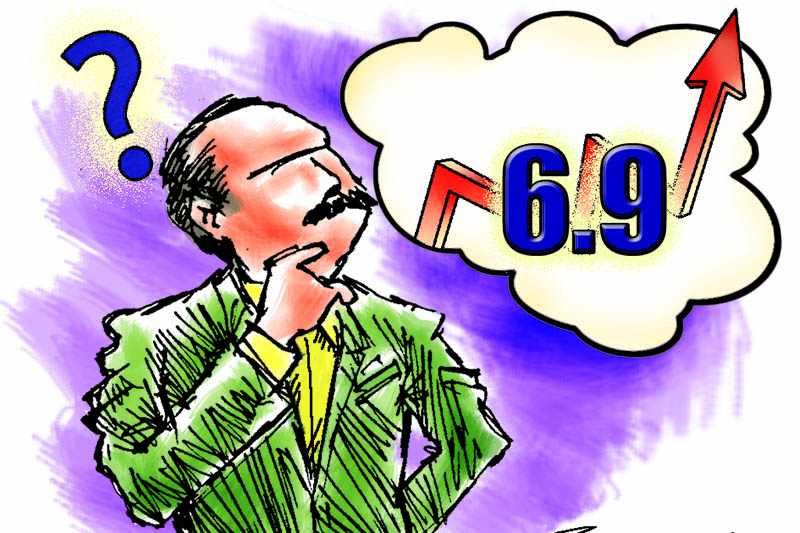High growth trajectory: Reality assessment
Unless a better and less risky alternative investment environment is available, mere pleading to the banks for investing in productive areas cannot take place. It has so far been used as a gimmick to hide the policy and institutional flaws
The national accounts estimates for the current fiscal year 2016/17 are out. They show that the GDP at basic prices will be at 6.9 percent which is one of the highest in Nepal’s growth history.
Apparently, it shows that, after devastating effect, the revival in the economy is in the full swing with the hope of economy entering into the high growth trajectory. For this to materialize, it is, however, a prerequisite that the bases of estimates are realistic and portray the prospects of sustained higher growth.
As a part of revival in the economy, a jump in imports followed by rapid expansion in private sector led industrial, tourism and business activities is taking place amidst very high negative growth in most of these sectors in the last fiscal year.
Some positive growth in commodity exports is also taking place. Ending of load shedding and regular supply of electricity is also contributing to the revival process.
Similarly, a record increase in food production has pushed up agriculture production. Massive rise in banking sector credit has boosted consumption and other related economic activities. Though very slowly, the reconstruction work is also going on.
But there are also some areas where the performance is worse or less satisfactory with likely adverse or no strong positive growth effect. The government budgetary performance is the best example of this. Out of Rs 312 billion capital expenditure provisioned in the budget, only 26 percent has been spent in 9 months. Progress in even major projects of national pride is dismal. It should also not be forgotten that even the low expenditure level conceals various leakages and misuse practices.
Evidently, the low capital expenditure has been one of the principle means of liquidity crisis in the banking system. The slowdown in the growth of remittances inflows has added credit crunch problem in the banking system leading to steep rise in lending rate with very adverse effect on private sector investment.
In net terms, it seems that, despite accounting gains due to last fiscal year’s low growth of just 0.01 percent, the overall growth rate estimated still is based on either less realistic bases or very optimistic expectations for the remaining months of this fiscal year.
A quick cross check of GDP expenditure components such as investment and exports indicate such a possibility. Ignoring the ground reality as indicated above, total investment has been estimated to be rising at more than 29 percent at the real prices. Similarly, export growth is estimated to be rising at more than 15 percent despite its growth being 12.8 percent at current prices in 8 months.
Needless to add, these in the identity frame contribute as growth enhancing components. As all expenditure components are counterparts of value added in one way or the other, they reveal the possibility of GDP estimated to be at a very higher side in contrast to the ground reality.
In view of GDP being very sensitive from the policy ramifications standpoint, an immediate revisit of estimates may be desirable.
Importantly, when all the factors including their bases are considered in the light of sources of higher growth or contributing factors, again sustainability of higher growth issue comes to the forefront more prominently.
Monsoon based agriculture is an added challenge in this regard. It is well-known that apart from traditional inputs like labor and capital, productivity is the key for the sustained higher growth. For this, investment in most productive human and physical capital is essential which is lacking in Nepal. To boost private investment also this is essential.
It is a matter of serious concern that in Nepal, not only 90 percent of the government expenditure is made in recurring expenses but also remaining allocation in capital heads is also not spent fully and properly.
As such, project and program priory has been a ritualistic work without compatibility with stated objectives. Still decades old expenditure framework setting project and program priorities are there. More broadly, the present resource allocation and uses system is obsolete and rotten with little help to augment growth in a sustainable way.
Similarly, the macro and other policies are such that they induce private investment more exclusively in non-tradable consumable and unproductive areas. The entire banking system is accustomed to invest in such areas as a means of reaping massive profits more quickly.
Unless a better and less risky alternative investment environment is available, mere pleading to the banks for investing in productive areas cannot take place. It has so far been used as a gimmick to hide the policy and institutional flaws.
Therefore, the foremost necessities are deep rooted systemic reforms in the budgetary system grounded on performance based budgetary scheme in which transparent and accountable system forms an integral part.
Similarly, the monetary, financial and trade policies also need overhauling simultaneously to ensure productive investment and thereby boost production and productivity, key to reverse worsened external trade imbalance as well.
If huge potentials are tapped properly and judiciously along with deep rooted reforms in key strategic areas, two digit growth in a more sustained way will not be a distant possibility.






